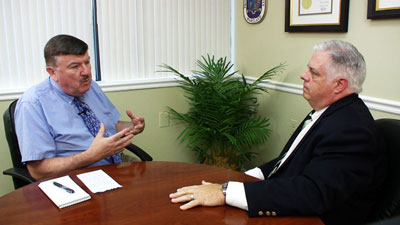Officials told reporters on Friday that the guard is working with the U.S. Cyber Command, the Cybersecurity & Infrastructure Security Agency and federal and local law enforcement to detect and prevent election interference.
According to assistant adjutant general and commander of the Washington National Guard, Brig. Gen. Gent Welsh, involving the military in election security makes sense.
“You don’t train people and corporations and the state public sectors to do this kind of work,” he said at a press conference.
“Most of the security is built around making sure the walls are higher and the lights are blinking green,” he said. The guard however, is trained “to do cyber missions against other military structures.”
Army Gen. Paul Nakasone, commander of the U.S. Cyber Command and director of the National Security Agency, issued an Election Day statement saying “vigilance – today and every day – isn’t just a watchword, it’s a matter of democracy.”
“Americans can rest assured: thousands of your fellow citizens stand ready to defend your vote, every single day,” he said.
The Army and Air National Guard’s 38 cyber operations units are staffed by over 2,200 personnel, while the guard has an additional 2,240 people to provide support.
The 14 states are Arizona, Colorado, Connecticut, Delaware, Hawaii, Iowa, Illinois, Louisiana, North Carolina, New Mexico, New York, Pennsylvania, Washington, and West Virginia, according to Defense One.
This is not the guard’s first time assisting states with elections. In the May primaries, the guard assisted eight states with election cybersecurity.
Although reticent about discussing specific operational threats, Maj. Gen. Todd Hunt, adjutant general of the North Carolina National Guard, said his state’s guardsmen have conducted over 45 cybersecurity missions this year. He said requests for assistance may include cyber help against ransomware, malware or credential harvesting.
Hunt also said the North Carolina Guard has provided preemptive cyber hygiene training and network education for many of the state’s 100 counties. He called the guard a “touch point between federal and local agencies when it comes to cyber.”
Welsh agreed, speaking to the vertical flow of communication up and down the chain of state and federal cybersecurity.
“You actually have folks in uniform, folks with security clearances that can pass data both up to Cyber Command in a very quick way… and in some cases, some of the highest levels of security information (can be passed) down to a state that can be fingered through as appropriate,” Welsh said.
Since Russia’s 2016 operations to obstruct U.S. elections, the Department of Defense has increasingly focused on interagency partnership to undermine foreign interference.
The declassified 2017 Intelligence Community Assessment, a joint report on Russian election involvement, found that Russian President Vladimir Putin ordered operations aimed at increasing then-presidential candidate Donald Trump’s election chances.
The report found that although the Kremlin directed a complex campaign of covert and overt cyber and messaging strategies, the systems used for tallying U.S. votes remained unaffected.
Meanwhile, the Cybersecurity & Infrastructure Security Agency notes on its web page that “while important commonalities exist across and within states, each state, local, and territorial election jurisdiction administers its elections under a unique legal and procedural framework using varying systems and infrastructure.”
“The differences and complexity introduced by this decentralization can lead to uncertainty in the minds of voters; uncertainty that can be exploited by malicious actors,” the agency said.
To combat misinformation, the agency maintains an election security fact-checking page at https://www.cisa.gov/







Recent Comments